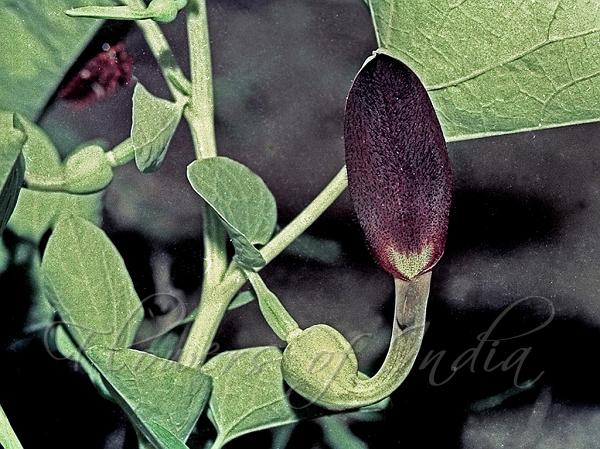|
| Worm Killer |
|

|

| File size | 293026 |
| Original date | |
| Resolution | 1024 x 768 |
| Flash | Flash did not fire |
| Focal length | |
| Exposure time | 1/11s |
| Aperture | 0.0 |
| Focus Distance | |
| Metering Mode | Multi-segment |
| Camera make | Wolverine |
| Camera model | COACH |
| Sensor type | OneChipColorArea |
|
|
|
|
Photo: |
Botanical name: Aristolochia bracteolata Family: Aristolochiaceae (Birthwort family)
Synonyms: Aristolochia kotschyi, Aristolochia abyssinica
Synonyms: Aristolochia kotschyi, Aristolochia abyssinica
Worm Killer is a herb mentioned in Ayurveda for the
treatment of intestinal worms. It is a perennial, or rarely annual,
mostly prostrate but occasionally climbing or nearly erect,
unpleasantly smelling herb growing from 10-40 cm long. The stem is
smooth and little twining. The branches are sharp and small. The leaves
are 2-3 inches long, kidney shaped and membranous. The under-surface
has small mesh like structure. The flowers are purple colored, single,
1.5-2 inches long. They are inflated and spherical at the base,
continuing as a long flower tube, ending in a tongue-shaped, brightly
colored lobe. There are no petals. The calyx is 1-6 1-3 whorled, and
3-6 toothed. The sepals are united. There are 6-40 stamens in one
whorl. They are united with the style, forming a gynostemium. These
flowers have a specialized pollination mechanism. The plants are
aromatic and their strong scent attracts insects. The inner part of the
flower-tube is covered with hairs, acting as a fly-trap. These hairs
then wither to release the fly, covered with pollen. The fruits are
oval to round shape, 1 inch long. The seeds are triangular and flat.
Worm Killer is found in North and South India.
Medicinal uses: The paste of the leaf of
Kitamari is applied over the wounds for helping in quick healing. The
decoction of the leaf is consumed in a dose of 50 ml to treat
dysmenorrhea and difficulty in labor. The decoction of the bark or
whole plant is taken in a dose of about 40 ml to treat intestinal worm.
The paste of the leaf of Kitamari is applied over eczema for its
treatment. The powder of the seed is given with powder of black pepper
to treat fever. The paste of the root is applied over the area over
localized swelling for its treatment.
The paste of the leaf of
Kitamari is applied over the wounds for helping in quick healing. The
decoction of the leaf is consumed in a dose of 50 ml to treat
dysmenorrhea and difficulty in labor. The decoction of the bark or
whole plant is taken in a dose of about 40 ml to treat intestinal worm.
The paste of the leaf of Kitamari is applied over eczema for its
treatment. The powder of the seed is given with powder of black pepper
to treat fever. The paste of the root is applied over the area over
localized swelling for its treatment.
Medicinal uses:
 The paste of the leaf of
Kitamari is applied over the wounds for helping in quick healing. The
decoction of the leaf is consumed in a dose of 50 ml to treat
dysmenorrhea and difficulty in labor. The decoction of the bark or
whole plant is taken in a dose of about 40 ml to treat intestinal worm.
The paste of the leaf of Kitamari is applied over eczema for its
treatment. The powder of the seed is given with powder of black pepper
to treat fever. The paste of the root is applied over the area over
localized swelling for its treatment.
The paste of the leaf of
Kitamari is applied over the wounds for helping in quick healing. The
decoction of the leaf is consumed in a dose of 50 ml to treat
dysmenorrhea and difficulty in labor. The decoction of the bark or
whole plant is taken in a dose of about 40 ml to treat intestinal worm.
The paste of the leaf of Kitamari is applied over eczema for its
treatment. The powder of the seed is given with powder of black pepper
to treat fever. The paste of the root is applied over the area over
localized swelling for its treatment. | Identification credit: P.S. Sivaprasad | Photographed in Nilambur, Coimbatore distt., Tamil Nadu. |
• Is this flower misidentified? If yes,